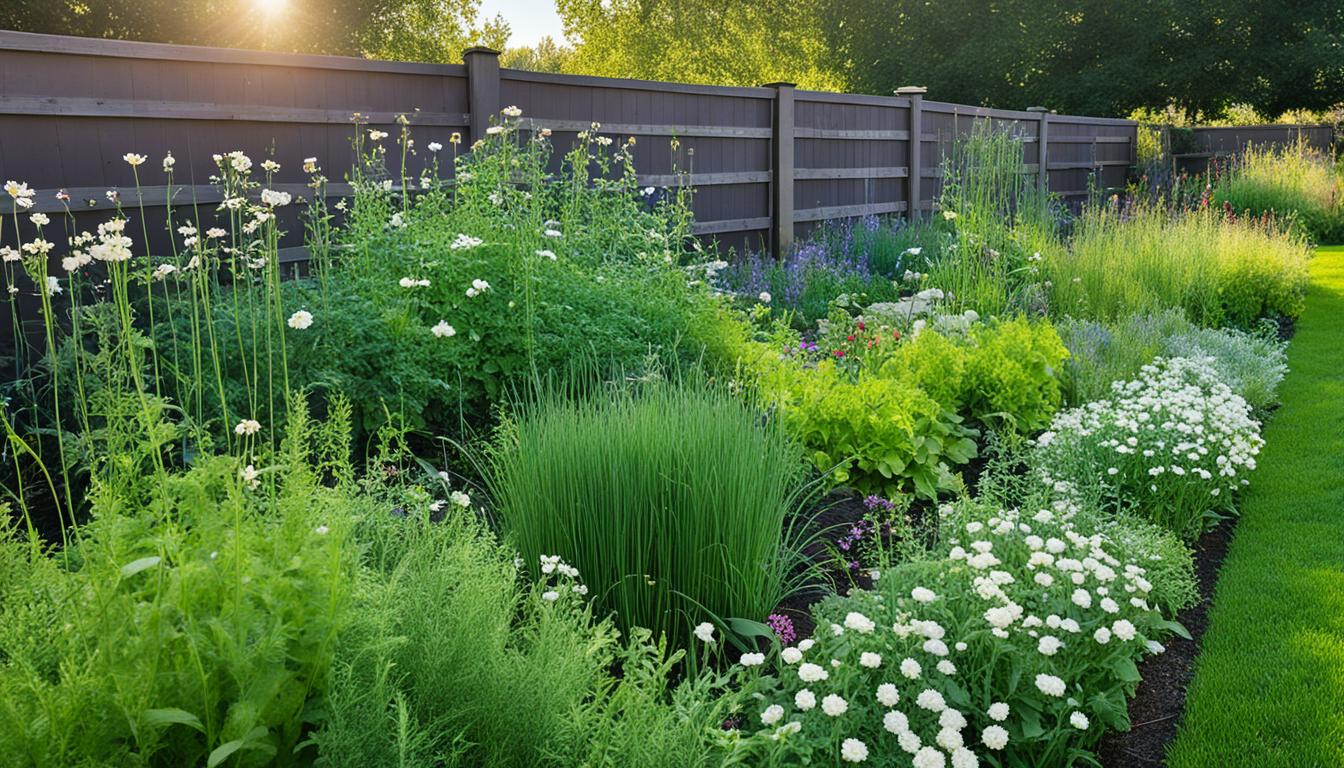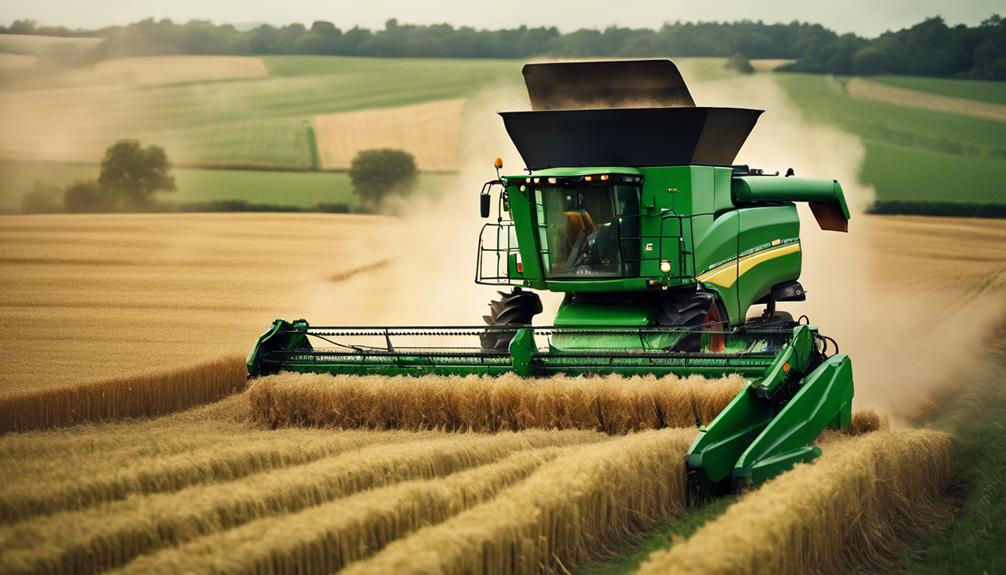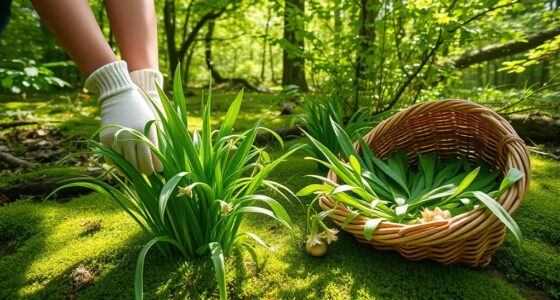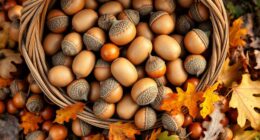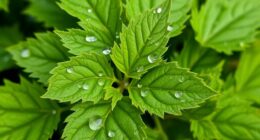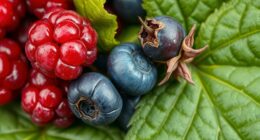Prepare for your mushroom foraging adventure by gathering a bag with a bottom that is porous, a sharp knife, tick-proof clothes, repellent, and a mushroom guide. Learn the basics of mushrooms such as the cap, gills, and habitat. Prioritize safety by wearing tick gear, avoiding unfamiliar fungi, and seeking guidance. Identify common edible mushrooms like King Bolete and Chicken of the Woods. Look for mushroom-friendly environments near trees and in shady, damp areas. Remember the importance of sustainable foraging to protect nature. Share additional helpful tips for a successful mushroom foraging experience.
Key Takeaways
- Pack a foraging bag with a permeable bottom for spore dispersal.
- Use tick-proof clothing and repellent to prevent bites.
- Focus on accurate mushroom identification to avoid toxicity risks.
- Consult reliable resources and experienced foragers for guidance.
- Harvest responsibly to protect wild mushroom populations.
Gear Up for the Hunt
Before heading out on a mushroom foraging adventure, make sure to gear up with essential equipment and protective clothing. Pack a foraging bag or basket with a permeable bottom to allow mushroom spores to disperse as you collect your finds.
Carry a sharp knife for mushroom identification and gentle gathering to make certain you handle them safely. It's important to equip yourself with tick-proof clothing, repellent, and tick tweezers to prevent any unwanted encounters while exploring the wild for fungi.
Consider using a GPS tracker to mark productive foraging spots and easily navigate your way back. Additionally, bring along a physical mushroom identification guide to assist in accurately identifying the wild fungi you come across.
Know Your Mushroom Basics

To safely and successfully forage for mushrooms, it's important to understand the basics of mushroom identification. Key terms like cap, gills, stalk, odor, habitat, and spore print play an essential role in distinguishing between different species.
Utilize reliable resources and exercise caution to make sure you can confidently identify edible mushrooms and avoid any potential risks.
Mushroom Identification
Familiarize yourself with essential mushroom terms like cap, gills, stalk, odor, habitat, and spore print to enhance your mushroom identification skills. Understanding these terms is vital when differentiating between various mushroom species.
To further improve your mushroom identification abilities, consider the following tips:
- Study Edible Mushrooms: Become familiar with common edible mushrooms that grow in your region. Knowing their distinct features will help you confidently identify safe options for consumption.
- Identify Habitat Indicators: Pay attention to the specific trees near which edible mushrooms often grow, such as beech, oak, or tulip poplar. Understanding their preferred habitat can guide your foraging efforts.
- Utilize Resources: Make use of field guides, high-resolution photo books, or reliable mushroom identification apps. These resources provide visual aids and detailed descriptions to assist you in accurately identifying mushrooms.
Safety Precautions
Are you confident in your ability to distinguish between edible and toxic mushrooms when foraging in the wild?
When it comes to safety precautions, proper identification is essential. Before consuming any wild fungi, it's vital to prioritize the accurate identification of mushroom species to avoid potential toxicity risks. Understanding terms such as cap, gills, stalk, odor, habitat, and spore print is key for differentiating between edible and toxic varieties.
To guarantee reliable mushroom identification, utilize a physical guide with high-resolution photos rather than solely relying on online resources. Stay cautious of potentially toxic mushrooms and their look-alikes to prevent accidental ingestion of harmful fungi.
Enhancing your knowledge about mushroom habitats, preferred tree associations, and key features can greatly improve your foraging safety and success. Remember, when in doubt, it's always better to err on the side of caution and consult with experienced foragers or mycologists for proper guidance.
Prioritize Safety Measures

Consider safety as your top priority when starting mushroom foraging expeditions. Prioritize safety measures to guarantee a successful and secure experience:
- Always carry a mushroom identification guide and learn to distinguish key features like cap shape, gills, and spore color to stay safe while foraging.
- Utilize tick-proof clothing and repellents, as well as tick tweezers, to prevent tick-borne illnesses during mushroom hunting trips.
- Avoid picking unidentified fungi and prioritize easily recognizable mushrooms to minimize the risk of accidental poisoning.
Identify Common Edible Varieties
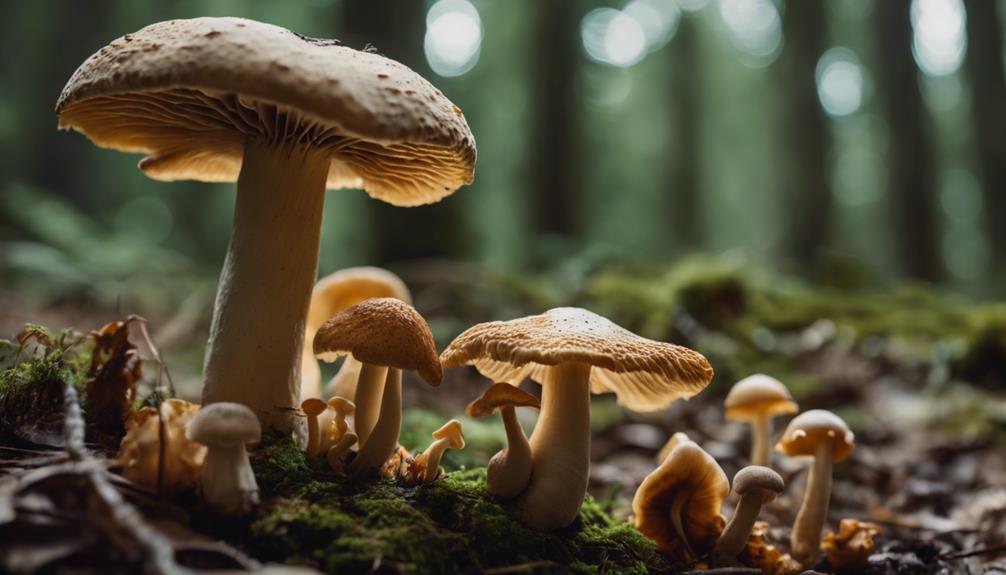
To successfully navigate the world of mushroom foraging, understanding common edible varieties is key.
When Mushroom Foraging, keep an eye out for the sought-after King Bolete, also known as Boletus edulis. This meaty-textured mushroom is a prized find.
Another delectable option is the Chicken of the Woods, scientifically named Laetiporus sulphureus. Its vibrant orange color and delicious taste make it a favorite among foragers.
Morels, belonging to the Morchella genus, are easily recognizable by their honeycomb appearance and offer an earthy flavor that enhances dishes.
Lobster mushrooms, scientifically known as Hypomyces lactifluorum, are unique as they're actually a parasitic fungus that transforms its host into a red-orange delicacy.
Lastly, don't overlook the Giant Puffballs, or Calvatia gigantea, which are best harvested when young and firm. These large, round white mushrooms are perfect for culinary use when found during your Mushroom Foraging adventures.
Learn Mushroom Habitat Clues
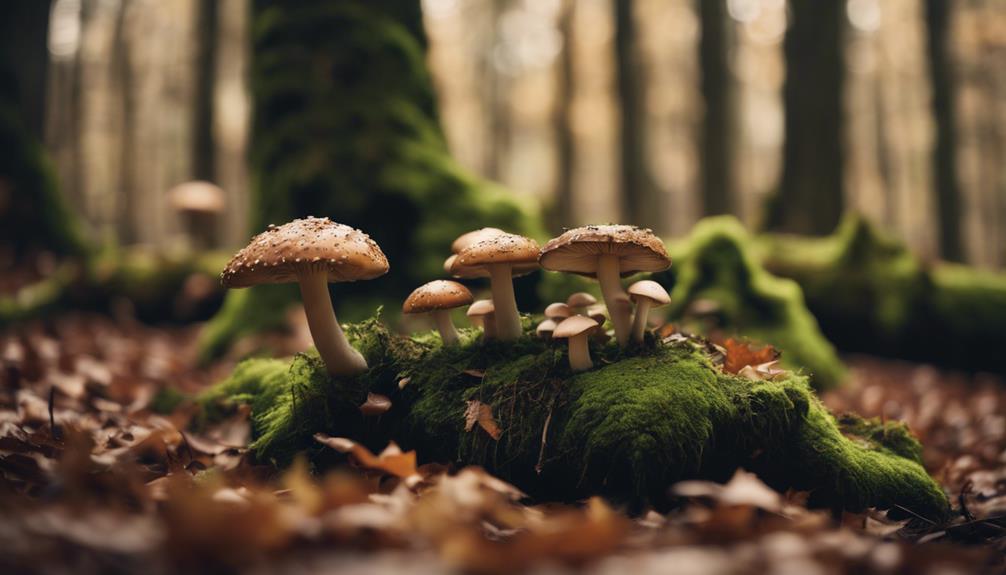
Exploring mushroom habitat clues involves observing specific trees, ground cover, and signs of mycelium networks to locate potential fruiting bodies during your foraging expeditions.
To enhance your understanding, consider the following tips:
- Tree Association: Look for mushrooms near oak, beech, or tulip poplar trees, as certain species have a symbiotic relationship with these tree types.
- Prime Locations: Search in moist and shady areas, especially on north-facing slopes, as these environments provide the ideal conditions for mushroom growth.
- Ground Cover Indicators: Pay attention to moss, leaf litter, or fallen branches, as they can signify a suitable habitat for various mushroom species to flourish.
Practice Ethical Foraging Techniques
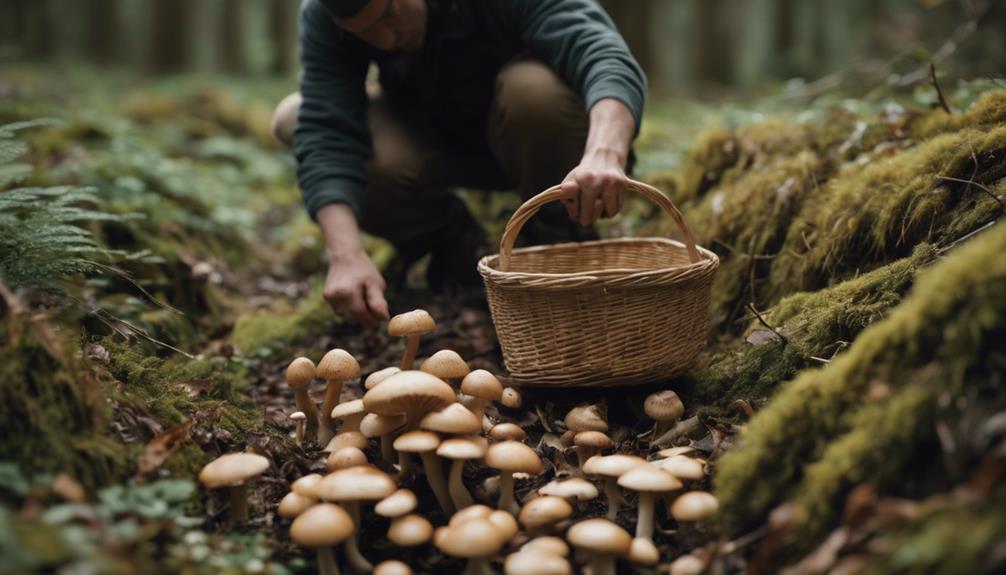
When foraging for mushrooms, prioritize practicing important harvesting techniques to guarantee the sustainability of wild fungi populations. Ethical foraging involves only taking what you can use, preventing overexploitation of mushroom habitats.
Leave no trace by minimizing your impact on the environment and respecting wildlife habitats during your foraging excursions. It's vital to practice sustainable foraging by following regulations, respecting private property, and obtaining permits when necessary.
Avoid damaging vegetation or disturbing wildlife while searching for mushrooms in their natural habitats. By adhering to these ethical foraging practices, you contribute to the preservation of wild fungi populations and their ecosystems.
Consider giving back by supporting conservation efforts or participating in restoration projects to help maintain the delicate balance of nature. Remember, ethical foraging and sustainable practices ensure that future generations can also enjoy the wonders of wild mushrooms.
Expand Your Foraging Knowledge

To broaden your mushroom foraging expertise, it's essential to understand safety precautions, how to identify edible mushrooms accurately, and practice sustainable foraging techniques.
By familiarizing yourself with these key points, you can confidently navigate the forests and fields in search of a bountiful harvest.
Enhancing your knowledge in these areas won't only guarantee a safe foraging experience but also contribute to the preservation of mushroom populations for future generations.
Safety Precautions for Foraging
Before starting your mushroom foraging journey, make sure you prioritize safety by accurately identifying mushrooms to prevent potential toxicity.
When venturing into the world of wild fungi, consider the following safety precautions:
- Research: Familiarize yourself with the common toxic mushrooms in your foraging area to avoid any potential risks.
- Consult Experts: Seek guidance from experienced foragers or local mushroom clubs to enhance your knowledge and skills.
- Use Resources: Utilize field guides and expert advice to confidently navigate the diverse world of mushrooms.
Identifying Edible Mushrooms
Researching and recognizing edible mushrooms can greatly enhance your foraging skills and broaden your knowledge of safe food sources in the wild.
When identifying edible mushrooms, it's essential to focus on species that are known for their taste and culinary versatility. For example, Yellow Chanterelles (Cantharellus Appalachiensis) are highly sought after for their distinct flavor and texture, making them a popular choice among foragers.
Lung Oysters (Pleurotus species) are another common find, prized for their delicate taste and ability to complement various dishes.
Additionally, Golden Milk-Caps (Lactarius anicola) are recognizable for their vibrant color and mild flavor profile, while Hygrophorus Milky (Lactarius Hygrophoroides) mushrooms, a type of Milk Cap variety, are safe for consumption and enjoyed for their taste.
Remember that even though Indigo Milk Caps (Lactarius Indigo) are edible, they may not be the most flavorful among Milk Cap species. By familiarizing yourself with these edible mushrooms, you can confidently identify safe and delicious options while foraging.
Sustainable Foraging Practices
When engaging in foraging activities, it's crucial to adopt sustainable practices to protect the environment and guarantee the longevity of wild mushroom populations. Sustainable foraging practices involve harvesting mushrooms responsibly to preserve ecosystems and prevent overexploitation.
To make sure you're foraging sustainably, consider the following tips:
- Respect regulations: Always be aware of local laws and guidelines regarding foraging to avoid damaging delicate ecosystems.
- Take only what you need: Harvesting only what you can use helps prevent depletion of mushroom populations and allows them to continue to reproduce.
- Leave habitats undisturbed: Minimize your impact by being mindful of where you walk and avoiding unnecessary disruption to the natural habitat.
Frequently Asked Questions
How Do You Harvest Fungi?
To harvest fungi, use a sharp knife to cut them at the base, preventing damage to the mycelium. Carry a permeable bag to spread spores. Mark spots with a GPS tracker. Avoid pulling them and harvest in moderation.
How Do You Hunt for Fungi?
When hunting for fungi, tread softly in nature's secret garden. Seek near friendly trees and in shadow's cool embrace. Use a trusty guidebook for clues, but beware the digital forest whispers. Happy foraging!
What Is the Proper Way to Pick a Mushroom?
To pick a mushroom correctly, use a sharp knife to cut it at the base of the stem. Handle it gently to protect the spores and mycelium. Place it in a breathable bag, avoid overcrowding, and always leave some behind for future growth.
Conclusion
Now that you've mastered the art of mushroom foraging, you're practically a fungi expert! Remember, safety first, always double-check your identification, and respect nature's delicate balance.
Happy hunting, and may your baskets be forever filled with delicious wild treasures. Keep exploring the world of wild fungi with caution and curiosity, and who knows what hidden gems you'll discover in the forest next!




